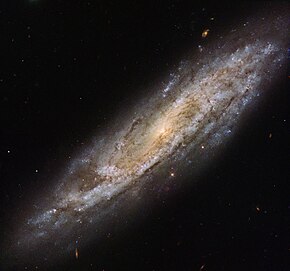| NGC 2770 | |
|---|---|
 NGC 2770 imaged by the Hubble Space Telescope in 2020 NGC 2770 imaged by the Hubble Space Telescope in 2020 | |
| Observation data (J2000 epoch) | |
| Constellation | Lynx |
| Right ascension | 09 09 33.622 |
| Declination | +33° 07′ 24.29″ |
| Redshift | 1943±1 km/s |
| Distance | 77 Mly (24 Mpc) 88 Mly (27 Mpc) |
| Apparent magnitude (V) | 12.0 |
| Characteristics | |
| Type | SBc |
| Apparent size (V) | 1.967′ × 0.511′ (NIR) |
| Notable features | Four supernovae |
| Other designations | |
| HOLM 111A, IRAS 09065+3319, UGC 4806, MCG +06-20-038, PGC 25806, CGCG 180-047 | |
NGC 2770 is a spiral galaxy in the northern constellation of Lynx, near the northern constellation border with Cancer. It was discovered by German-born astronomer William Herschel on December 7, 1785. J. L. E. Dreyer described it as, "faint, large, much extended 150°, mottled but not resolved, 2 stars to north". NGC 2770 was the target for the first binocular image produced by the Large Binocular Telescope.
The morphological classification of SBc indicates a barred spiral with moderately-wound arms. The physical properties of this galaxy are similar to those of the Milky Way. The combined mass of stars in the galaxy is estimated at 2.1×10 M☉, and it has a star formation rate of ~1.1 M☉ y. There are no apparent perturbations of the galaxy due to suspected interaction with the companion galaxy, NGC 2770B.
Supernovae

Four supernovae have been observed in NGC 2770:
- SN 1999eh (type Ib, mag. 17.5) was discovered by Mark Armstrong on 12 October 1999.
- SN 2007uy (type Ib, mag. 17.2) was discovered by Yoji Hirose on 31 December 2007.
- SN 2008D (type Ib, mag. 17.5) was discovered by NASA's Swift X-ray telescope on 9 January 2008, while observing SN 2007uy. It was the first supernova detected by the X-rays released very early on in its formation, rather than by the optical light emitted during the later stages, which allowed the first moments of the outburst to be observed. It is possible that NGC 2770's interactions with a suspected companion galaxy may have created the massive stars causing this activity.
- SN 2015bh was discovered by the Catalina Real-time Transient Survey and Stan Howerton on 7 February 2015, and was either a Type II supernova or the hyper-eruption of a luminous blue variable.
See also
References
- ^ Skrutskie, Michael F.; et al. (1 February 2006). "The Two Micron All Sky Survey (2MASS)". The Astronomical Journal. 131 (2): 1163–1183. Bibcode:2006AJ....131.1163S. doi:10.1086/498708. ISSN 0004-6256. S2CID 18913331.
- van Driel, W.; et al. (November 2016). "NIBLES: an H I census of stellar mass selected SDSS galaxies. I. The Nançay H I survey". Astronomy & Astrophysics. 595: 43. arXiv:1607.02787. Bibcode:2016A&A...595A.118V. doi:10.1051/0004-6361/201528048. S2CID 118623916. A118.
- ^ Ann, H. B.; et al. (2015). "A Catalog of Visually Classified Galaxies in the Local (z ~ 0.01) Universe". The Astrophysical Journal Supplement Series. 217 (2): 27–49. arXiv:1502.03545. Bibcode:2015ApJS..217...27A. doi:10.1088/0067-0049/217/2/27. S2CID 119253507.
- Soderberg, Alicia; et al. (May 22, 2008). "An extremely luminous X-ray outburst at the birth of a supernova". Nature. 453 (7194): 469–474. arXiv:0802.1712. Bibcode:2008Natur.453..469S. doi:10.1038/nature06997. PMID 18497815. S2CID 453215.
- ^ "NASA/IPAC Extragalactic Database". Results for NGC 2770. Retrieved 2008-05-26.
- ^ Thöne, C. C.; et al. (March 2017). "SN 2015bh: NGC 2770's 4th supernova or a luminous blue variable on its way to a Wolf-Rayet star?". Astronomy & Astrophysics. 599: 29. arXiv:1606.09025. Bibcode:2017A&A...599A.129T. doi:10.1051/0004-6361/201629968. S2CID 56266352. A129.
- "NGC 2770". SIMBAD. Centre de données astronomiques de Strasbourg. Retrieved 2020-09-07.
- Seligman, Courtney. "NGC Objects: NGC 2600 - 2649". Celestial Atlas. Retrieved 2020-09-07.
- "LBT Press Release - First Binocular Light". Archived from the original on 2011-07-25. Retrieved 2008-05-22.
- ^ Thöne, Christina C.; et al. (June 2009). "NGC 2770: A Supernova Ib Factory?". The Astrophysical Journal. 698 (2): 1307–1320. arXiv:0807.0473. Bibcode:2009ApJ...698.1307T. doi:10.1088/0004-637X/698/2/1307. S2CID 118697339.
- Hurst, G. M.; Armstrong, M.; Boles, T. (1999). "Supernova 1999eh in NGC 2770". International Astronomical Union Circular (7282): 1. Bibcode:1999IAUC.7282....1H.
- "SN 1999eh". Transient Name Server. IAU. Retrieved 8 December 2024.
- Nakano, S.; Kadota, K.; Itagaki, K.; Corelli, P. (2008). "Supernova 2007uy in NGC 2770". International Astronomical Union Circular (8908): 2. Bibcode:2008IAUC.8908....2N.
- "SN 2007uy". Transient Name Server. IAU. Retrieved 8 December 2024.
- Kong, A. K. H.; MacCarone, T. J. (2008). "A Giant X-ray Flare in NGC 2770". The Astronomer's Telegram. 1355: 1. Bibcode:2008ATel.1355....1K.
- Li, W.; Filippenko, A. V. (2008). "Supernova 2008D in NGC 2770". Central Bureau Electronic Telegrams. 1202: 1. Bibcode:2008CBET.1202....1L.
- "SN 2008D". Transient Name Server. IAU. Retrieved 8 December 2024.
- "Catching the Light of a Baby Supernova". Gemini Observatory. Archived from the original on 23 August 2015. Retrieved 7 July 2015.
- Bishop, David. "Bright Supernovae - 2015: SN 2015bh". Rochester Astronomy. Retrieved 8 December 2024.
- "SN 2015bh". Transient Name Server. IAU. Retrieved 8 December 2024.
Further reading
- "Imposter or the Real Deal?". www.spacetelescope.org. Retrieved 6 January 2020.
External links
- [REDACTED] Media related to NGC 2770 at Wikimedia Commons
- Astronomers Witness Supernova's First Moments
- NASA Astronomy Picture of the Day: Supernova Factory NGC 2770 (18 January 2008)
- NGC 2770 on WikiSky: DSS2, SDSS, GALEX, IRAS, Hydrogen α, X-Ray, Astrophoto, Sky Map, Articles and images
| New General Catalogue 2501 to 3000 | |
|---|---|
| |